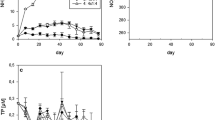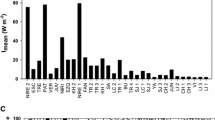Abstract
The paper reports the impact of a sharp artificial enrichment of the available phosphorus in a small, acidic and oligotrophic corrie lake and its effects upon the phytoplankton supported. Annual average chlorophyll increased tenfold within two years, from ∼ 1.2 to 12.6 µg chl a l-1, but the species represented by large populations are the same as previously. Chrysophyte species, however, make up a smaller fraction of the total crop.
Similar content being viewed by others
References
Davison, W., 1987. Internal elemental cycles affecting the long-term alkalinity status of lakes: implication for lake restoration. Schweiz. Z. Hydrol. 49: 186–200.
Davison, W., D. G. George & N. J. A. Edwards, 1995. Controlled reversal of lake acidification by treatment with phosphate fertilizer. Nature 377: 504–507.
Davison, W., C. S. Reynolds, E. Tipping & R. F. Needham, 1989. Reclamation of acid waters using sewage sludge. Envir. Poll. 57: 251–274.
Lund, J.W. G., 1959. A simple counting chamber for nannoplankton. Limnol. Oceanogr. 4: 57–65.
Lund, J. W. G., C. Kipling & E. D. Le Cren, 1958. The inverted microscope method of estimating algal numbers and the statistical basis of estimations by counting. Hydrobiologia 11: 143–170.
Lund, J.W. G. & J. F. Talling, 1957. Botanical limnological methods with special reference to the algae. Bot. Rev. 23: 489–583.
Moss, B., 1973. The influence of environmental factors on the distribution of freshwater algae: an experimental study. IV. Growth of test species in natural lake waters and conclusion. J. Ecol. 61: 193–211.
Rawson, D. S., 1956. Algal indicators of trophic lake types. Limnol. Oceanogr. 1: 18–25.
Reynolds, C. S., 1992. Eutrophication and the management of planktonic algae: what Vollenweider couldn't tell us. In D.W. Sutcliffe & J. G. Jones (eds), Eutrophication; research and application to water supply. Freshwater Biological Association, Ambleside: 4–29.
Reynolds, C. S., 1998. What factors influence the species composition of phytoplankton in lakes of different trophic status? Hydrobiologia 369/370: 11–26.
Rodhe, W., 1948. Environmental requirements of freshwater plankton algae: experimental studies in the ecology of phytoplankton. Symb. bot. Upsaliensis 10: 5–149.
Shannon, C. E., 1948. A mathematical theory of communication. Bell Syst.tech. J. 27: 623–656.
Talling, J. F., 1974. General outline of spectrophotometric methods. In R. A. Vollenweider (ed.), A manual on methods for measuring primary production in aquatic environments. Blackell Scientific Publications, Oxford: 22–25.
Talling, J. F. & D. Driver, 1963. Some problems in the estimation of chlorophyll-a in phytoplankton. In U.S. Atomic Energy Commission (ed.), Proceedings, Conference on primary productivity measurements, marine and freshwater, Hawaii, 1961. USEAC, Washington: 142–146.
Youngman, R. E., 1971. Algal monitoring of water supply reservoirs and rivers. Tech. Memo. Wat. Res. Ass. 63: 1–26.
Rights and permissions
About this article
Cite this article
Reynolds, C.S., Jaworski, G.H.M., Roscoe, J.V. et al. Responses of the phytoplankton to a deliberate attempt to raise the trophic status of an acidic, oligotrophic mountain lake. Hydrobiologia 369, 127–131 (1998). https://doi.org/10.1023/A:1017022631862
Issue Date:
DOI: https://doi.org/10.1023/A:1017022631862




